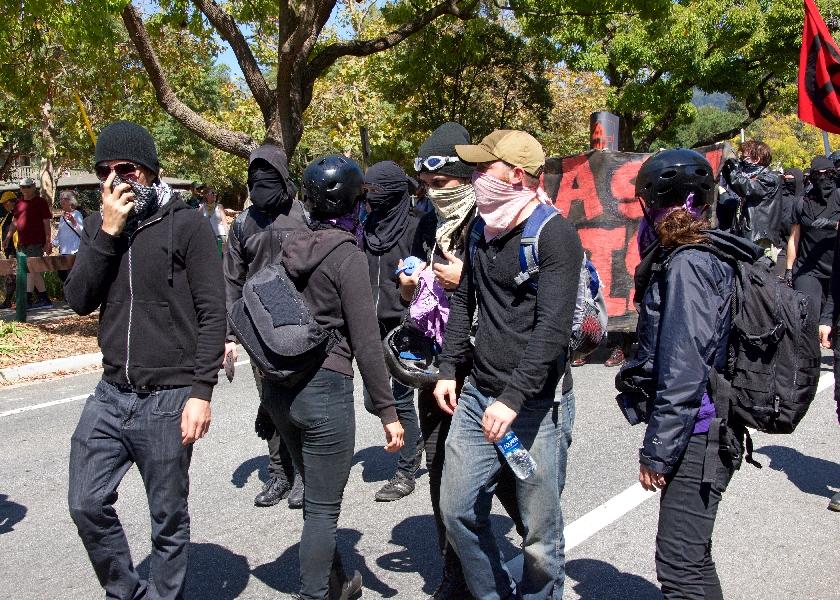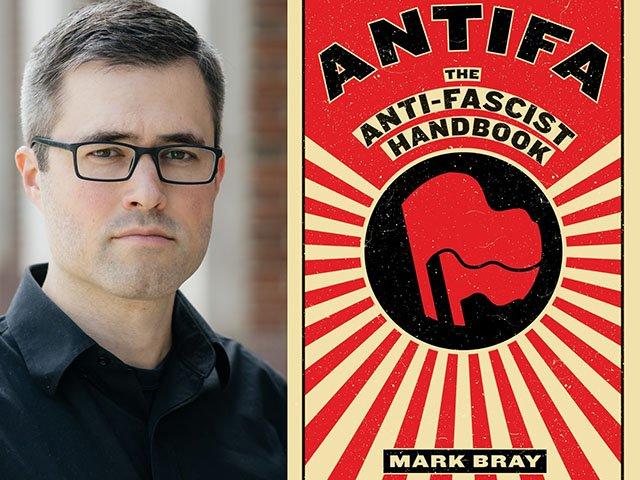What ‘Academic’ Antifa Wants
Tyler Durden
Mon, 06/01/2020 – 20:50
Update (2000ET): Right on cue, as Andy Ngo reports below, the mainstream media joins the #DefendAntifa narrative against Trump’s orders with an op-ed in The Washington Post from none other than Mark Bray:
On cue, @washingtonpost published a column by #antifa academic Mark Bray to give the perspective (propaganda). Bray used to teach at Dartmouth, whose president repudiated him for advocating political violence. Proceeds from Bray’s antifa handbook were donated to an antifa fund. pic.twitter.com/ilgaNEl3in
— Andy Ngô (@MrAndyNgo) June 1, 2020
* * *
Authored by Alexander Riley via Campus Reform,
In a fully sane culture, the category ‘Antifa professor’ would be a contradiction in terms. The calling of the college professor entails a deep commitment to the power of facts and arguments to change minds. Antifa, on the other hand, is a loose collection of half-educated malcontents who entirely reject the logic of intellectual debate. They aim not to change the minds but rather to crush the skulls of those with whom they disagree, in the manner of sociopathic criminals throughout human history.
Yet contemporary American higher education has produced a number of ‘Antifa professors’ who are currently holders of academic positions. They are engaged in the paradoxical business of making what they purport is an intellectual case for a thuggishly anti-intellectual movement. They include such figures as Michael “Dead cops are good” Isaacson and George “All I want for Christmas is White Genocide” Ciccariello-Maher.
Among this cast, Mark Bray distinguishes himself as the only one who has produced an Antifa handbook. (As a matter of principle, I will not link to the book–the entire text can be found for free online, should you want a look without having to put any money in Bray’s pocket). He has appeared on “Meet the Press” and been written about in The Chronicle of Higher Education, in both cases with significant coddling.
I had not paid any attention to him until he was recently invited to speak at Bucknell University, where I teach, by the Humanities Center. This gave me the excuse to look closely at his book on Antifa. I am glad to have done so, for it provides a useful blueprint for the whole movement of “academic Antifa,” and now I have a much firmer sense of just how dangerous that movement is.
The task to which the “Antifa professors” have set themselves is the same one the Communist International took up in the 1930s when it advanced the ideological line that essentially all parties and ideologies to the right of Marxism-Leninism were de facto fascist because, like the fascists, they opposed the coming to power of Marxist communist regimes. Clearly, some chicanery is required to make a case that not x=x, that is, non-fascists are fascists, with the goal of justifying treating both groups equally, that is, violently. Here’s how Bray eliminates the boundary between real fascists and assorted individuals and groups he dislikes that show absolutely no discernible connection to fascism:
“From Tom Hanks in Saving Private Ryan…to Indiana Jones, nothing seems to delight American moviegoers more than killing Nazis…But would those same moviegoers consider it just as heroic to fight Nazis before… Hitler even took power in 1933? How would America respond to a cinematic depiction of communist…organizations…when they fought the Nazi[s]…in the 1920s and ‘30s? I like to imagine most Americans would sympathize with these militant formations because they know that the story ultimately ends in the gas chambers. So why then are so many Americans allergic to…the prospect of physically confronting fascists and white supremacists…?…Antifa argue that we should always remember that few took seriously the small bands of followers around Mussolini and Hitler when they started their ascent, and therefore we should remain vigilant against any and every manifestation of fascistic politics.” (Antifa: The Anti-Fascist Handbook, pp. 170-171, 172)
Did you get that? Anyone who agrees that the killing of Nazis by soldiers in a war is justified ought to understand “physically confronting fascists and white supremacists,” e.g., at college campuses as an equivalent moral imperative. What precisely is meant by “physically confronting,” we are not told. Should fascists and white supremacists merely be physically prevented from speaking? Should they be beaten? What if they insist on speaking despite efforts to prevent them from speaking, or defend themselves against Antifa beatings? How much is Antifa morally permitted to amplify “physical confront[ation]” in such cases? All of this is left conveniently unclear by Mr. Bray.
Something even more crucial is left just as unclear here. How is it to be determined that the individuals Antifa desires to “physically confront” are indeed “fascists and white supremacists”? If they are actual Nazis, wearing swastikas and overtly announcing their violent and racist desires to expel “racial enemies,” the work is easy. But this is an infinitesimally small group, perhaps a few thousand in a country of 320 million (around 0.003%), and Mr. Bray is in no way content to restrict the category nearly so significantly:
“[W]e must recognize the relationship between two…registers of anti-fascism: analytical and moral. The analytical…consists of mobilizing historically informed definitions…of fascism to craft anti-fascist strategy [for]…facing ideologically fascist groups…The moral register developed out of the rhetorical power of…calling someone or something fascist…[Here] the anti-fascist lens is applied to phenomena that may not be fascist, technically speaking, but are fascistic. For example, were the Black Panthers wrong to call cops who killed black people with impunity “fascist pigs” if they did not personally hold fascist beliefs or if the American government was not literally fascist? At a Madrid Antifa demonstration, I saw a rainbow flag with the slogan “homophobia is fascism.” Does the existence of non-fascist homophobes invalidate the argument?…[T]he moral register of anti-fascism understands how ‘fascism’ has become a moral signifier that those struggling against a variety of oppressions have utilized to highlight the ferocity of the political foes they have faced and the elements of continuity they share with actual fascism…The challenges of defining fascism make the line between these two registers blurry…a key component of anti-fascism is to organize against both fascist and fascistic politics in solidarity with all those who suffer and struggle” (Antifa, pp. 134, 135)
And a few pages along, Bray elaborates further:
“[M]ilitant anti-fascism is but one facet of a larger revolutionary project. Many Antifa groups organize not only against fascism, but aim to combat all forms of oppression such as homophobia, capitalism, patriarchy, and so on. In that way, they see fascism as only the most acute versions of larger systemic threats. When I spoke with members of Pavé Brûlant [Burning Pavement] in Bordeaux, they continually stressed that all major political parties…manifested fascistic traits… It’s surreal to watch liberal pundits lambast anti-fascists for disrupting a fascist speech, when their revolutionary socialist ideology advocates the global expropriation of the capitalist ruling class and the destruction…of all existing states by means of an international popular uprising that most believe will necessitate violent confrontation with state forces. If they are critical of ‘no platforming,’ wait ‘til they hear about class war” (Antifa, pp. 158, 159).
It is not then only “fascists and white supremacists” who can be legitimately met with Antifa violence. It is also individuals or groups Antifa has defined as “homophobes,” supporters of “patriarchy,” capitalism, and the police, finally, all those who participate in unnamed “variet[ies] of oppression” and thereby oppose “all those who suffer and struggle.” All these categories of potential targets, I remind you, are to be defined and determined by the members of Antifa. Mark Bray does not define them anywhere in his book with any precision at all.
Can you imagine why he might abstain from doing this?
I can.
It’s because “academic Antifa” wants the answer to the question “Who is a fascist?” to be “Anyone Antifa says is a fascist, that’s who.”
Bray’s invocation of the Black Panthers is particularly telling. We should recall that by the early ’70s, factions of the Panthers were openly calling for armed struggle by blacks against the American government. One offshoot of the Black Panthers, the Black Liberation Army, orchestrated perhaps as many as thirteen carefully planned assassinations of police officers. These are Mark Bray’s ideological heroes and models.
One last bit from Bray, just to make crystal clear where the noxious teaching of “academic Antifa”is intended to leave us:
“Our goal should be that in twenty years those who voted for Trump are too uncomfortable to share that fact in public. We may not always be able to change someone’s beliefs, but we sure as hell can make it politically, socially, economically, and sometimes physically costly to articulate them” (Antifa, p. 206)
This rather lets the cat completely out of the bag, no? If you exercise your right to vote in a way that does not meet Antifa approval, then you are a legitimate target of criminal violence. The ranks of the “fascistic” have now swollen to around 63 million, which is the number of votes Trump received in 2016.
Those “academic Antifa” actively professing such ideas are still, at this point, a small minority in American higher education—though the fraction of the college professoriate they represent could easily be higher than the fraction of the American population that consists of white supremacists and Nazis. There are however many more working in colleges and universities who help give these ideas oxygen—by assigning books like Antifa, by inviting people like Mark Bray to speak on their campuses, by pretending that antifa are about something more sophisticated or noble than the desire for the violent destruction of the American civil sphere.
An important step in challenging this drift in the direction of “academic Antifa” is simply to report, accurately and in detail, on what these people say, write, and believe. Virulent ideas should be exposed to clean air and bright light. Among other positive effects, this allows the people who are largely paying the salaries of individuals like Mark Bray and his professorial supporters at Dartmouth and elsewhere, that is, the parents of college students and donors to institutions of higher education, to see precisely how their money is being spent.
via ZeroHedge News https://ift.tt/2yUFk8f Tyler Durden

